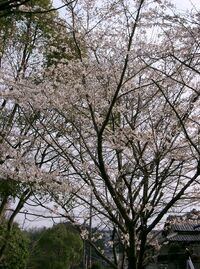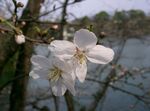Prunus × yedoensis, (Yoshino Cherry or in Japanese: 染井吉野 Somei-yoshino) is a species of hybrid cherry tree with an unknown origin, though it is believed to be a cross between the Oshima Cherry (Prunus speciosa) and the Higan Cherry (Prunus subhirtella). It is naturally endemic to Japan where it has been cultivated for a while in Yoshino, Nara (which is the derivation of its name) and other places; it is currently a very popular and is one of the most widely planted cultivated flowering cherries, or sakuras, in temperate areas across the world.[1][2][3]
Description[]

Yoshino cherry tree foliage.
The Yoshino Cherry is a deciduous tree that will usually grow to be 5–12 m at maturity, but will sometimes grow from 15–16 m tall. It grows well in hardiness zones from 5–8 and does well in full sun and moist, yet well drained soils. Its bark is purple to gray in color, with bands of cork-like lenticels. The leaves are arranged in an alternate position, elliptic or obovate, reaching from 6–15 cm long by 4–7 cm broad. They usually have a bronze tone when newly emerged, but become darker green during summer and serrated or sharp-toothed margins. The flowers usually emerge before the leaves in spring, 3–3½ cm in diameter. They are fragrant, with five petals that begin as a pale pink, but over time become white in color. The flowers will grow in clusters of five or six. When the flowers mature, they form a drupe 8–10 mm in diameter, which are important food sources for many birds and mammals, including robins and thrushes. They contain a small amount of flesh and a very concentrated red juice which is known to stain clothing and bricks. It is only slightly sweet to the human's taste.[1][2][3]
Cultivation and uses[]

Yoshino cherry tree.
Due to the tree's fragrant, pink flowers, manageable size, and elegant shape, the Yoshino cherry is sometimes used for ornamental purposes. Many cultivars of the Yoshino cherry exist, among them are 'Akebono', 'Ivensii', and 'Shidare Yoshino'.[1]
It was introduced to Europe and North America in 1902, and was first planted in the United States in 1912 as a gift of friendship from Japan.[4][3] The Yoshino cherry, along with the 'Kanzan' cultivar of Prunus serrulata is responsible for the pink show each spring in Washington, D.C. and in other cities. About 2000 Yoshino cherries were gifted to the citizens of Toronto by the citizens of Tokyo in 1959. These were planted in High Park.
From the Edo period to the early Meiji period, gardeners and craftsmen who founded the village at Somei, Edo (now Komagome, Toshima ward, Tokyo), grew the Yoshino cherry. They first offered them under the name, "Yoshinozakura". In 1900, the tree was renamed in Japanese to someiyoshino by Dr. Fujino.[5]
Gallery[]
References[]
- ↑ 1.0 1.1 1.2 Huxley, A., ed. (1992). New RHS Dictionary of Gardening. Macmillan ISBN 0-333-47494-5.
- ↑ 2.0 2.1 Rushforth, K. (1999). Trees of Britain and Europe. Collins ISBN 0-00-220013-9.
- ↑ 3.0 3.1 3.2 Eyewitness Companions: Trees. Ridsdale, C. et al. (2005) ISBN ISBN 0-7566-1359-0
- ↑ Cite error: Invalid
<ref>tag; no text was provided for refs namedafm - ↑ "染井吉野". 語源由来辞典. http://gogen-allguide.com/so/someiyoshino.html. Retrieved 2011-01-09.(Japanese)
- ↑ Prunus × yedoensis on Wikipedia





